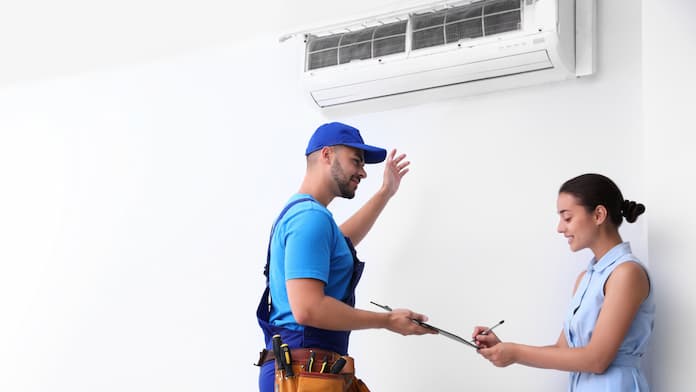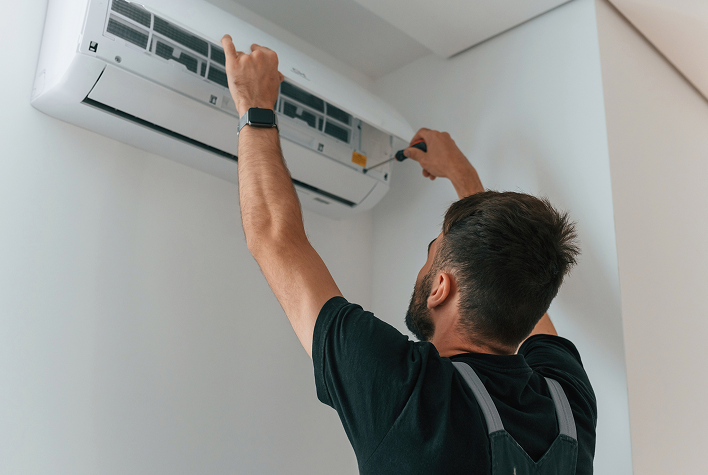Key Points
- The cost of replacing an air conditioner depends on unit size, efficiency rating, and installation complexity.
- Larger or high-efficiency units typically cost more upfront but provide better long-term energy savings.
- Additional expenses may include ductwork upgrades, electrical modifications, and permits.
- Labor rates and regional pricing differences can significantly affect the total project cost.
- On average, homeowners spend between $5,900 and $23,600 for a complete AC replacement.
What Factors Can Affect the Average Cost of Air Conditioner Replacement?

Size of the Unit
- Smaller units (1–2-ton capacity)$3,000 - $5,000
- Medium units (3–4-ton capacity)$4,000 - $7,000
- Large units (5+ ton capacity)$6,000 - $10,000+
The size you need depends on your home’s square footage, layout, insulation, and local climate. A 1-ton unit typically covers 400-600 square feet. Undersized units strain to cool your home, while oversized units cycle on and off too frequently, wasting energy. Professional HVAC technicians use Manual J calculations to determine the right size for your home.
Energy Efficiency (SEER Rating)
- Basic efficiency (13-16 SEER)$3,000 - $6,000
- Mid-range efficiency (17-20 SEER)$5,000 - $8,000
- High efficiency (21+ SEER)$7,000 - $12,000+
SEER (Seasonal Energy Efficiency Ratio) measures cooling output versus energy consumption. Higher SEER ratings mean better energy efficiency but higher upfront costs. However, they can lead to significant energy savings over time, especially in hot climates or homes with heavy AC usage. The minimum SEER rating for new installations varies by region, typically ranging from 13 to 14 SEER.
Brand and Model
- Economy brands (e.g., Goodman, Payne)$3,000 - $5,000
- Mid-range brands (e.g., Rheem, American Standard)$4,500 - $7,500
- Premium brands (e.g., Carrier, Lennox, Trane)$6,000 - $10,000+
Well-known brands often cost more but may offer better reliability, longer warranties, and more advanced features. Some premium brands use proprietary components, which can increase repair costs but may also improve performance. Research customer reviews and reliability ratings when choosing a brand.
Installation Complexity
- Simple AC system replacement cost$3,000 - $5,000
- Moderate difficulty$5,000 - $8,000
- Complex installation$8,000 - $15,000+
Factors like difficult access, ductwork modifications, or electrical upgrades can increase costs. Simple replacements involve swapping out the old unit for a new one of similar size and type. Complex installations might include moving the unit location, reinforcing floor joists for heavier units, or upgrading your home’s electrical panel to handle a more powerful system.
Electrical Works
- Basic electrical connections$200 - $500
- Upgrading electrical panel$1,000 - $4,000
- Installing new circuit$500 - $1,500
- Rewiring$1,500 - $3,000+
Electrical work is often necessary when installing a new AC unit, especially if you’re upgrading to a more powerful system or your home’s electrical setup is outdated. Basic electrical connections involve hooking up your new AC to existing wiring and are typically included in standard installation costs.
If your current panel can’t handle the new AC’s power requirements, you may require upgrading your electrical panel. This is more common in older homes or when significantly increasing your AC’s capacity. Installing a new circuit is often required for larger or more efficient AC units that need their dedicated power line.
Geographic Location
- Low-cost areas (e.g., Midwest, rural areas)10-20% below average
- Average-cost areas (e.g., suburbs, smaller cities)Standard pricing
- High-cost areas (e.g., major cities, coastal regions)10-30% above average
Labor cost to replace an AC unit varies by region due to differences in living costs, competition among HVAC companies, and local regulations. Coastal areas may have higher costs due to corrosion-resistant units needed for salty air. Some states offer rebates or tax incentives for energy-efficient units, which can offset higher costs.
Season
- Off-season (fall/winter)Potential discounts of 10-20%
- Peak season (spring/summer)Standard or slightly higher pricing
Installing during off-peak times can save money as HVAC companies are less busy. However, extreme weather might make installation challenging. Some companies offer financing options or payment plans that can make peak-season installations more affordable.
Additional Features
- WiFi compatibility$50 - $300
- Zoning systems$2,000 - $3,500
- Air purification systems$500 - $1,500
- Variable-speed compressors$1,000 - $2,500 extra
- Noise-reducing features$200 - $500
These extras can enhance comfort and efficiency. WiFi-enabled thermostats allow remote control and scheduling. Zoning systems provide customized temperatures for different areas of your home. Air purification systems can improve indoor air quality, which is especially beneficial for allergy sufferers.
Ductwork Condition
- Minor repairs$200 - $500
- Partial replacement$1,000 - $3,000
- Full replacement$3,000 - $10,000+
Poor ductwork can significantly impact your new AC’s efficiency. Leaky or poorly insulated ducts can waste up to 30% of your system’s energy. Duct sealing can improve efficiency for a relatively low cost. In older homes, asbestos in duct insulation may require professional remediation, significantly increasing costs.
Refrigerant Type
- R-410A systemsStandard pricing
- R-32 systems5-10% higher initial cost
The phase-out of R-22 (Freon) has led to new refrigerant types. R-410A is currently standard, but some newer systems use R-32, which has a lower environmental impact. R-32 systems may have a higher upfront cost but can be more energy-efficient.
Permits and Inspections
- Permit fees$50 - $300
- Inspection fees$100 - $500
Many localities require permits and inspections for AC installations. These ensure that the work meets local building codes and safety standards. Some HVAC companies include these fees in their quotes, while others list them separately.
Should You Install the Air Conditioner Yourself or Hire a Professional?
When it comes to installing an air conditioner, you have two options: doing it yourself or hiring a professional. Each of these options has its unique benefits and drawbacks. The table below outlines the pros and cons of both choices to help you decide which is best for you.
DIY Installation
TABS
Hiring a Professional
TABS
By carefully weighing these pros and cons, you can make an informed decision on whether to tackle the installation yourself or hire a professional. Each option has its own set of benefits and potential drawbacks, so consider your budget, skills, and needs before making a choice.
How Can You Find a Professional AC Unit Installer?
Finding a professional AC unit installer is crucial for ensuring your new system works efficiently and safely. Here are several general recommendations to help you find the right professional for the job:
Homebuddy.com is a great service for finding professional AC unit installers. It connects homeowners with vetted, local HVAC professionals. The platform saves time by doing the initial screening for you. It also provides access to pre-vetted, qualified professionals, offers a simple way to compare multiple quotes, and helps ensure you’re getting a fair price for quality work.
What Questions Should You Ask an AC Installation Professional?
When hiring an AC installation professional, asking the right questions can help ensure you get the best
How to Reduce AC Replacement Cost
Replacing an air conditioner can be expensive, but there are several ways to reduce the cost. Here are some tips to help you save money when installing a new AC unit in your house:
By following these tips, you can significantly reduce the cost of replacing the A/C unit. Taking a proactive approach and exploring all available options can lead to substantial savings and a more budget-friendly installation.
Conclusion
Understanding the costs associated with AC replacement empowers homeowners to make informed decisions. While prices can vary widely based on factors like unit size, efficiency, and installation complexity, there are many ways to potentially reduce costs without compromising on quality.
Remember to get multiple quotes, consider energy efficiency for long-term savings, and choose a reputable installer. With careful planning and smart choices, you can stay cool and comfortable without breaking the bank.
Frequently Asked Questions
When is the most suitable time to install or replace an air conditioning unit?
The best time to install or replace an AC unit is during the off-season, typically fall or early spring. During these periods, HVAC companies are less busy, which can lead to better pricing and more flexible scheduling. The cooler weather also makes the installation process more comfortable for technicians, potentially leading to a quicker and more efficient installation.
How long does it take to install a central air conditioner?
Installing a central air conditioner typically takes 1-3 days, depending on the complexity of the job. A straightforward replacement of an existing system might be completed in a single day. However, if ductwork modifications or electrical upgrades are needed, the installation could take up to 3 days. Always allow for some flexibility in your schedule to accommodate any unexpected issues.
What is the expected service time for an HVAC unit?
The average lifespan of a well-maintained HVAC unit is about 15-20 years. However, this can vary based on factors such as usage, climate, and maintenance quality. Regular professional servicing (ideally twice a year) can help extend your unit’s lifespan. If your unit is over 10 years old and requires frequent repairs, it might be more cost-effective to replace it.
Which AC model is the most cost-effective?
Models with a SEER rating of 16-18 often offer the best balance between upfront cost and long-term energy savings for most homeowners. Brands like Goodman, Rheem, and American Standard frequently offer good value. However, the most cost-effective model can vary based on your specific needs, local climate, and energy prices. It’s best to consult with a local HVAC professional for personalized recommendations.
How often should I install a new air conditioner?
You should consider installing a new air conditioner every 10-15 years, depending on its condition and efficiency. If your unit is over 10 years old and experiencing frequent breakdowns, or if your energy bills are steadily increasing, it might be time for a replacement. Also, if your current unit uses R-22 refrigerant (which is being phased out), replacing it sooner rather than later could be more cost-effective.
How can I qualify for a government discount on installing a new conditioner?
To qualify for government discounts on a new AC installation, look for Energy Star-certified models, which often qualify for federal tax credits. Check the Database of State Incentives for Renewables & Efficiency (DSIRE) website for state and local incentives. Many utility companies also offer rebates for energy-efficient AC installations. Be sure to keep all receipts and certification documents to claim these incentives when filing your taxes.
